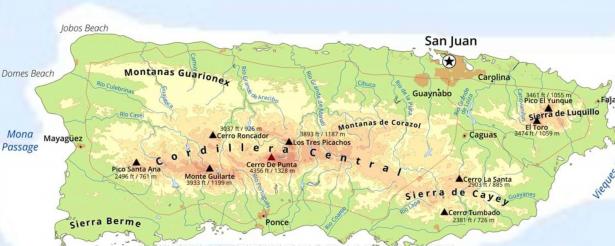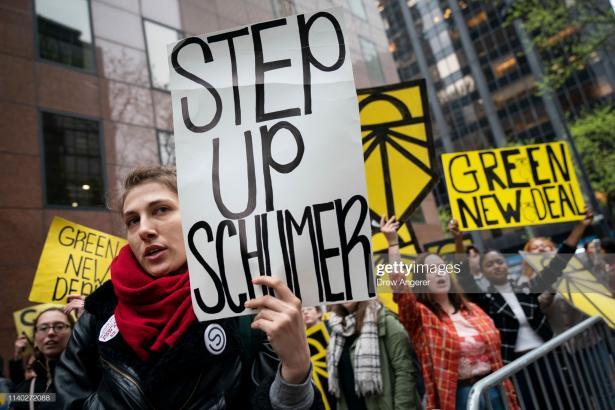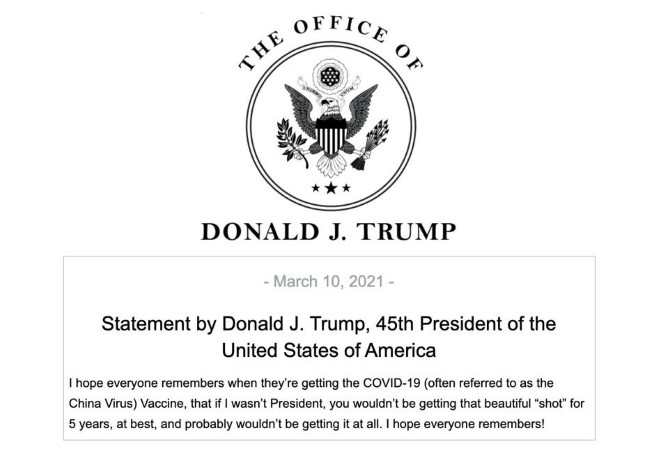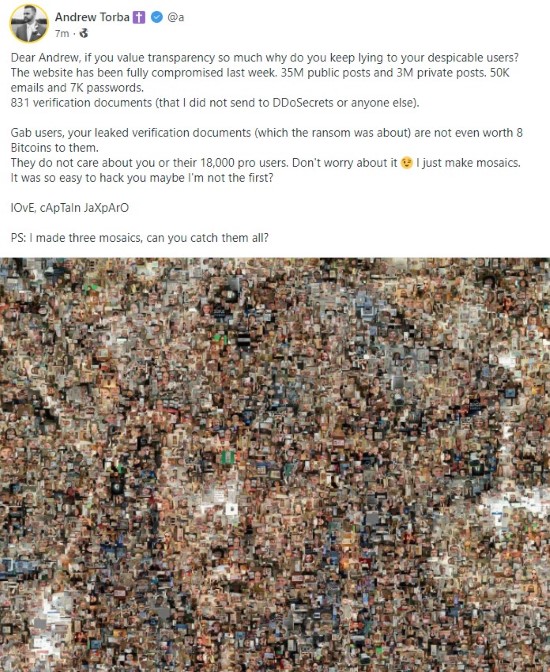You cannot say nothing will change. We can make the argument that not enough is changing fast enough. These are not nitpicking questions, because this is how the language we use communicates to individuals who is included, who you consider a person.
March 27, 2021
Don McIntosh
Democratic Left is the magazine of the Democratic Socialists of America. Signed articles do not necessarily express the position of the organization
DEMOCRATIC LEFT

Alexandria Ocasio-Cortez on her way to speak at NYC’s Women’s March, Photo by Corey Torpie
Bronx Congresswoman Alexandria Ocasio-Cortez, best known as AOC, is DSA’s foremost socialist superstar. Her June 2018 primary win—a 29-year-old taqueria bartender defeating the third most powerful Democrat in the U.S. House of Representatives—inspired up to 10,000 people to join DSA.
The Netflix documentary Knock Down the House details her life story leading up to that victory. Since then, her influence has only grown. Earnest, fun, relatable, and fierce, she became one of Congress’ best known members overnight, and used the attention to pull the national conversation leftward. In October 2019, her endorsement revivified Bernie Sanders’ campaign following his heart attack.
Today—with over 12 million Twitter followers, her picture on the December cover of Vanity Fair, and mass cultural appeal to teens and the not-yet-political—she continues to use her unasked-for celebrity to build support for a democratic socialist agenda. On Jan. 28, more than a quarter of a million people streamed her impromptu teach-in on the gamer platform Twitch.tv. The topic was the GameStop stock market rebellion, but the discussion encompassed a critique of Wall Street and a plug for a wealth tax.
AOC spoke with me by Zoom Jan. 26.
What was your path to joining DSA?
I love this question because I think that my path in DSA very much shaped my organizing strategy. I didn’t grow up in an incredibly ideological household. I have friends that grew up the children of unionists, professors, individuals two or three generations deep into working class movements. That was not my family. I grew up very working class. My mother cleaned houses. My father had a small business. Both my parents grew up in extreme poverty.
What initially drew me to DSA was the fact that they showed up everywhere that I showed up. I started my work as a community organizer before I even knew about the existence of DSA, and I was busy doing work in my community, working with children, working with families, advocating for educational equity. A friend of mine invited me to a DSA meeting in the Bronx/Upper Manhattan Branch. We were in the basement of a church uptown, in Washington Heights I believe. It was my first time being exposed to DSA, and to me it was like, ‘Okay, we’re hearing all this rhetoric and having discussions.’ And I’m like, ‘Okay, another group of folks talking.’ Like this is great, this is encouraging.
This was around the time when DSA was picketing one of the major camera companies in New York City, trying to call attention to the warehouse workers. And they brought undocumented warehouse workers to the meeting, and translated their testimony. And on top of that, the chapter had free childcare provided to anyone who wanted to show up. And that to me … at the end of that meeting, I was like, ‘Okay, this is real.’
You know, there’s a lot of people who talk about class issues, there’s a lot of people who are deep in the discourse of struggle. But to me, as someone who grew up in these environments, it was the translation to action that was distinctive to me.
That is what made DSA initially distinctive to me, and made it something that was flagged to me as worthy of continued attention. And then Jabari Brisport ran for City Council. It felt like something fundamentally different to me, even in the context of electoralism.
Ironically enough, before I ran for Congress, and before Jabari had run for City Council in that first race, I myself had huge doubts around electoralism. That’s why I dove into community organizing, because I was one of those folks that felt, “We’re not going to get any substantive change through electoral politics. It’s just not going to happen.”
I felt that way because I grew up around Bronx machine politics, where there was a lot of cynical use and weaponization of identity under the guise of lobbyist-driven policies and corporate policy. I had essentially given up on it, and I felt the only way we’re going to do this is by committing ourselves to our communities.
And so it was that first meeting that I felt, ‘Okay, this is something that’s real.’ Also, in the history of New York City and in communities of color, when you have the Young Lords and you have this organizing heritage, there has historically been tension between DSA and these organizing collectives of color, whether it was Latino and Puerto Rican collectives, Chicano collectives, black collectives…. It was like, “Oh, it’s these white folks. [LAUGHS.] There was this historical fissure. But it really felt like a moment where we were coming together. And so when I would see DSA showing up providing real structural support at BLM rallies, or support for abolishing ICE, where we felt like there wasn’t this class essentialism, but that this really was a multiracial class struggle that didn’t de-prioritize human rights, frankly, I was really impressed. And I felt like it was something worth being part of.
My run for Congress, so much of it was based in coalition building. In the New York City context, I wasn’t a DSA candidate that was homegrown from the start. I went through a process of earning the DSA endorsement. And that was in addition to stitching a collective together of the movement for Black lives and the movement for immigrant rights. Our congressional district is half immigrant, extraordinarily working class and just incredibly diverse in the Bronx and Queens. Along with Senator Sanders’s campaign, which I also proudly worked on, prior to all of this, you know, all of that, I think, really contributed to this moment.
And, for me, there’s a real distinction between us saying that we’re about something and us really being about it in our actions. And it was really that distinction, in the action and in the praxis, that made it distinctive to me and made it something to be a part of.
What a great story. Thank you for sharing that.
DSA’s priorities really are your priorities as well, Green New Deal and Medicare For All in particular. There’s no getting around the fact that each of those are going to require an act of Congress. What is the most strategic thing that DSA members and chapters could be doing right now to bring that about?
I’m a big believer in exercising a dual approach. First of all, I think you’re right, there is no Medicare For All without an act of Congress. The thing is legislation after all.
I think sometimes people fall into this trap of wishful thinking about a poll question, thinking that support is solid, and that it is unsusceptible to the propaganda of corporate lobbyists and the health insurance industry. I think the first thing we need is real honesty about the work to be done ahead of us. There are some issues that poll really well, and the polling is concrete. There are other issues that poll one way or another, and the polling can really fluctuate with just one ad campaign.
Actually, we experienced this in a positive way with the Green New Deal, in that the oil and gas lobbies have gone in so hard to try to give the Green New Deal a bad name. And even after the total hammering that it experienced by the Republican Party, it still doesn’t poll that poorly. However, one thing that we do see is that even in areas where it may not poll as well as we would like, what we find is that it’s highly susceptible to positive messaging. Once we go in and either send organizers, or have other forms of messaging, and actually explain what the Green New Deal is, polling skyrockets for the issue. And so, in terms of tactics and what’s needed, I think we need to actually make the case for single payer health care that is free of cost at the point of service. And we have to say what we mean by Medicare for All, because as we know, there are a lot of cynical actors that try to add all these ellipses, like “Medicare for All who want it that make less than $100,000 per year.” And that’s why we have to engage in the work of organizing.
So I would say in terms of our strategic priorities, yes, it’s continued organizing, yes, it’s also continued support on the state level, for various health care initiatives, such as the single payer proposal in the state of New York.
There’s a lot of that work that we can do outside of electoralism. But there is critical electoral work to be done as well. I think the strategy of supporting candidates, when that strategy is very calculated, focused, precise, when we aren’t casting our net too wide beyond the capacities of any given local organization, is extremely effective. Mounting continued primary challenges or just supporting candidates in general, putting candidates in open seats … I’ve seen the impact of it from the inside—how much even incumbent members of Congress will totally reinvent themselves in a far more progressive direction, because they know that their communities are watching.
In the best case scenario, we get incredible new members of Congress, or we win these open seats, you know, Rashida Tlaib was an open seat. And at worst, we get almost a radical change in the agenda of the incumbent that is presently there. And so in many ways, it’s a win-win in getting that internal traction, that is necessary.
We’ve heard again and again from conservative Democrats, that an AOC style agenda might fly in Queens or the Bronx, but it can’t win in more competitive districts out in Middle America. What’s your answer to that?
I think it’s totally false. I think that their critique may be more aesthetic, to be honest. After all, I was born in the Bronx, and I’m bred in this community. And this is my community. So of course, you know, if I just walk over to another state in Nebraska or whomever, they’re gonna suss out real quick that perhaps I’m not a Nebraskan. But I don’t think that that is really related to policy. I think it’s because I’m a New Yorker, and I act like a New Yorker. And you know what? I need to act like a New Yorker so that I can represent New York’s 14th Congressional District. But I don’t think that critique really holds water in terms of the actual policies that we are supporting. Sure, in terms of my style of advocacy, it’s not going to be the style of advocacy for another local community. But I’m aware of that. And that’s not my job. My job is not to represent any other district than mine right now.
It also applies the other way: They could not come to New York and to our district and be successful here. So it cuts both ways. And I think it’s important that we send the message that our communities are just as necessary, and just as critical as any other. But that said, again, this has nothing to do with the actual policy. A lot of times, it’s the style of that advocacy, and I think that you can just see the importance of a multiracial, and multi-identity, multi-gendered, geographically diverse movement. That’s ultimately the strength and beauty of our collective work with Bernie. There are communities that I’m able to speak to and organize, there are communities that Bernie and I are able to speak to and organize, and there are communities that Bernie is able to speak to and organize. And when we come together, we’re able to build trust, and expand that collective power among all the folks that resonate with each of us individually. The idea, like, “She’s not going to win in this one community or another community” … I’m not trying to, you know? What we’re trying to do is build movement in that community. And that is a very different question than trying to litigate one personality versus another.
Some on the Left have looked at Biden’s record and his differences with the Bernie wing of the party, and they conclude that no progress is going to come out of the Biden administration. What’s your view?
Well, I think it’s a really privileged critique. We’re gonna have to focus on solidarity with one another, developing our senses for good faith critique and bad faith critique. Because bad faith critique can destroy everything that we have built so swiftly. And we know this because it has in the past, and it’s taken us so many decades to get to this point. We do not have the time or the luxury to entertain bad faith actors in our movement. But also we have to value our solidarity with one another. For anyone who brings that up, we really have to ask ourselves, what is the message that you are sending to your Black and brown and undocumented members of your community, to your friends, when you say nothing has changed? Perhaps not enough has changed. And this is not a semantic argument. Just the other night, we in collective struggle were able to stop the deportations of critical members of our community. And that would not have happened in a Trump administration.
Thank you.
They were just on the belt ready to go. And you just cannot say that nothing will change. We can make the argument that not enough is changing fast enough. And these really are not nitpicking questions of semantics, because this is how the language that we use communicates to individuals who is included and who do you consider a person. When you say “nothing has changed,” you are calling the people who are now protected from deportation “no one.” And we cannot allow for that in our movement. That’s not a movement that I want to be a part of. And I know that’s not the movement that we are a part of. We’re so susceptible to cynicism. And that cynicism, that weaponization of cynicism, is what has and what continues to threaten to tear down everything that we have spent so much time building up. We’re allowed to win too, by the way. [LAUGHS.]
I prefer winning, actually.
Millions of people are excited about you being in Congress and rooting for your success. But at the same time, no other figure has been targeted by the Fox News crowd quite like you have. Why do you think that they worked to make you such a bogeyman for the right wing, and what’s it like to be on the receiving end of that?
I think they’ve done it because they know that we are a threat. Particularly because of the fact that I’m a movement candidate. If I was just some kind of one-off singular candidate, I do not believe that we would be attracting the energy and attacks that we attract. So much of this organized power and organized capital has frankly correctly identified that my candidacy is not an individual venture, but that it is representative of an actual working class movement. There is a rush to define me to the country before I have the opportunity to define myself. And if you can get enough people to just tune me out or tune any other person out before they even get the opportunity to hear what one has to say, you’re able to go a long way in preserving the current power structure. However, I don’t think that strategy lasts the test of time. I think it was a very strong short-term strategy. I mean, it continues to be a strategy. But I honestly believe that what was just attempted was: We’re going to throw the book at any candidate like this. We’re going to make an example out of her for everyone else. And then we’re just going to tar and feather her in the press. And then we’re going to mount a $3 million Democratic primary challenge against her that’s bankrolled by Wall Street, that was also a Latina, down to having a hyphenated last name. [Ed.: AOC was challenged in the 2020 Democratic primary by Michelle Caruso-Cabrera.] And it was just the most cynical, disgusting thing. But it was also trying to convince Democrats that this is too dangerous, and that this is a liability. They did that in hopes that it would succeed. And not only was it not successful, but we crushed them, just completely crushed them.
It was very exciting to see that result.
It is exciting, because they weaponized all the cynical powers of trying to get someone of my ethnicity, trying to even confuse people in terms of the name—Caruso Cabrera versus Ocasio Cortez. And [her campaign] had, you know, $3 million, she was a CNBC anchor, so she had TV and camera training and all of it. And the fact that it was so desperately unsuccessful, I think really speaks to the strength of this movement, that there is a glimmer of hope that it will not be distracted by all of the kind of tricks up this corporate establishment’s sleeve. And then beyond that, we went to a general election, which had $10 million behind it, backed by a Republican who then tried to do this whole … I might be getting my my music references mixed up, but trying to do like this whole like “John Mellencamp” vibe, trying to convince people that he’s not actually Republican, that he’s just a working class dude. So it really shows what their strategy was, which is “we’re gonna throw the book at her,” and we’re gonna try to wound her so badly that she doesn’t win re-election and this just becomes a flash-in-the-pan thing. I mean, in the general election it was the second most expensive congressional race in America.
I did not realize that.
Yeah, in the United States, it was the second most expensive race in the country. And so their strategy was to make quick work of us. And they threw everything that they could, and it didn’t work. And now I think they have a problem on their hands. [LAUGHS]
Yeah, because you got re-elected. In fact you absolutely crushed.
And not only that, but we also expanded our presence with the election of Jamaal Bowman and Cori Bush. It’s really showing that this is not going away.
You’re one of 435 representatives in the House, four of whom are open socialists now. Pessimists might look at that and find that daunting, but you put on a recent Twitter video in which you listed all the specific things you personally got done in two years. You tried to do it in two minutes. It took you four, talking as fast as you could. So for our readers, what are some of the most impactful items on that list?
Well, for me, I’m already thinking about this term so far, things that aren’t in the video but have already been early wins. And by the way, this just speaks to talking about how nothing will change … we’ve already had really two very significant wins. One non-electoral, which was the Hunts Point Produce workers, being able to support them in securing wage increases and protecting their health care in their strike efforts. [Ed.: At the nation’s largest wholesale produce market, located in the Bronx, Teamsters struck for first time in 35 years. AOC skipped the presidential inauguration to join them on the picket line. After a week on strike, they won $1.85 an hour raises]
The reason I bring this up is because I do not believe that they would have had the structural and community support they were able to generate, if we hadn’t been building momentum on both electoral wins and non electoral wins. You know, if Joe Biden didn’t win the presidency, that would have been a harder strike. Even though they don’t seem connected, there is something to be said about the morale of seeing your actions manifest into change. I don’t know if as many elected officials would have shown up if they didn’t feel like more people weren’t paying attention. And so to have that institutional support for their demands, really allowed the community to rally around, along with the on-the-ground support that DSA provided.
You know, I thought one of the things that was so inspiring in talking to many of these unionists was that they expressed to me shock, every night that I was there, that so many young people showed up to the picket line. They had no idea what was going on. But they were thrilled. And they knew that it was adding so much power to their strike efforts. And it really kind of goes both ways too. It elevated the consciousness of even the unionists, of the fact that they weren’t alone, and that their struggle was part of a larger collective one, really made the strike stronger. And the other [win] was being able to secure $2 billion for FEMA reimbursements for funeral expenses.
For those who died of COVID.
Yeah, for individuals who have died of COVID. And there’s a couple of reasons why this was so important. First of all, this was a homegrown effort. New York 14 was the most heavily impacted congressional district at the outbreak of the pandemic. And Elmcor and our constituents in East Elmhurst, which is kind of in the shadow of Elmhurst Hospital, the most heavily hit hospital in the country at one point, they reached out immediately. And they said, this is a disease that is disproportionately impacting people along lines of race and class. It is disproportionately impacting the Black, the brown and the low income. And as a consequence, the subsequent deaths, particularly at the beginning, were concentrated among Black patients, brown patients and low income patients.
So you take that a step further, and the expenses for a funeral can go $5,000 to $10,000. That is a life-altering expense for a working class family, when the average American has 400 bucks in savings, especially in the middle of a pandemic, when this is not something that is planned or expected at all. That’s the kind of death that is earth-shattering, that can put a family under for a decade plus, if not more. I experienced this myself when my family lost my dad, and we saw how expensive it was. And it took a decade to get out from that debt.
So when you target this for reimbursement, it’s actually quite a progressive cash transfer. Because when you are reimbursing those who have died of COVID, and COVID is disproportionately impacting the Black and the brown and the working class, you are able to lift those families or at least patch them through to prevent inequity and inequality from further bottoming out the bottom. And that’s the reason we prioritized it so much. The fact that we were able to actually pass it on to the Trump administration is pretty remarkable. We were able to get $2 billion authorized under Trump. Now that FEMA is operating under Biden, we can now work with the administration to administer these funds, and dole them out in a way that is not going to be as stonewalled or corrupt as it would be under the Trump administration.
One of the exciting things about your early days in Congress was your willingness to break from convention, like when you blew the lid on the freshman orientation that was crawling with corporate lobbyists, or appeared at the Sunrise Movement sit-in in Pelosi’s office. Has your strategy shifted at all from those days?
I don’t think so. I do think that the pandemic has complicated those things a little bit, because a lot of stuff really does happen behind closed doors. And it’s funny, but you know, people will say and do things at a cocktail party that they will not do on a Zoom call. So I would say that the opportunities for disruption have varied a little bit in this digital situation that we’re in, but I still think they exist.
One thing I do think has changed is that I do believe we’re getting more sophisticated. I think about all of our tactics as different tools in a toolbox. And when I first started, I had a hammer. And when you have a hammer, everything’s a nail, as they say. But then as you learn about other methods, you can get a wrench, and then you get a screwdriver, and then you’re able to add a lot more to your tools. You add the tools of electoralism — supporting other members to join. You have the tools of sunlight.
There’s this one moment I’ll never forget. We were going through the appropriations process, I believe in 2019 or so. And basically, this is how we fund the entire government, we go along and we fund each agency after the other. And there are these massive multi-thousand-page packages. And I remember finding … sometimes it’s as simple as hitting Control-F and just trying to find every policy-related keyword, to see what’s getting appropriated, and see what you can dig through. That’s literally how some folks go about this, when you’re given 1,000 pages of legislation 48 hours before it drops. But we found this really bizarre appropriation for fossil fuel facilities, and it was like a multi billion dollar giveaway, I believe, at the time. And we were like, “Where did this come from? Did someone slip this in?” And we were gonna propose an amendment to take it out. So we raised the question about this. And because no one wanted to ‘fess up and actually own that they were the one who put that in, it was withdrawn without actually making it a floor fight. Yeah. I don’t think we ever got to the bottom of who was behind that. Clearly, you know, this is lobbyist driven. This was a lobbyist’s language that someone asked to put in. But because the actual line item was so shameful, no one wanted to actually ‘fess up to the fact that they put this in.
There are so many of these wins, that aren’t necessarily public fights every time. They are wins to the tune of millions and billions of dollars that could then be shifted to other priorities. Some of that work is quiet, but it is just as significant as some of the public fighting and organizing. Not to disparage that either, but they complement one another.
You’re famous for skillfully clapping back at haters from time to time, but you don’t come off as mean, and you never punch down. How do you stay so positive?
Oh, thank you. Well, you know, positivity is an organizing tool. And I say that with so much earnestness. There’s a reason why Jabari [Brisport] won, there’s a reason why Zohran [Mamdani] won, there’s a reason why Marcela [Mitaynes] and Phara [Souffrant Forrest] — these wins that we had on the state level, why those candidates won. Look at them. They are relentlessly positive. They are people that you want to be around. And they are not cynical, and they do not engage in “more socialist than thou.” They are just relentlessly positive.
And I think the most important thing that we can do in order to win is to be people and spaces that people want to be around. And that is our organizing priority. We have to make Medicare for All something that everyone wants to be a part of. We have to make Green New Deal something that everyone wants to be a part of. I think people sometimes are dismissive of this, in thinking that it’s less serious than study. But who’s gonna join your book club if it sucks? Who’s gonna join your reading group if they feel judged? So the important thing we need to do is to really create something … excuse my language … but that’s fucking fun.

Photo by Corey Torpie
Don McIntosh is a member of the Democratic Left editorial team.

Alexandria Ocasio-Cortez on her way to speak at NYC’s Women’s March, Photo by Corey Torpie
Bronx Congresswoman Alexandria Ocasio-Cortez, best known as AOC, is DSA’s foremost socialist superstar. Her June 2018 primary win—a 29-year-old taqueria bartender defeating the third most powerful Democrat in the U.S. House of Representatives—inspired up to 10,000 people to join DSA.
The Netflix documentary Knock Down the House details her life story leading up to that victory. Since then, her influence has only grown. Earnest, fun, relatable, and fierce, she became one of Congress’ best known members overnight, and used the attention to pull the national conversation leftward. In October 2019, her endorsement revivified Bernie Sanders’ campaign following his heart attack.
Today—with over 12 million Twitter followers, her picture on the December cover of Vanity Fair, and mass cultural appeal to teens and the not-yet-political—she continues to use her unasked-for celebrity to build support for a democratic socialist agenda. On Jan. 28, more than a quarter of a million people streamed her impromptu teach-in on the gamer platform Twitch.tv. The topic was the GameStop stock market rebellion, but the discussion encompassed a critique of Wall Street and a plug for a wealth tax.
AOC spoke with me by Zoom Jan. 26.
What was your path to joining DSA?
I love this question because I think that my path in DSA very much shaped my organizing strategy. I didn’t grow up in an incredibly ideological household. I have friends that grew up the children of unionists, professors, individuals two or three generations deep into working class movements. That was not my family. I grew up very working class. My mother cleaned houses. My father had a small business. Both my parents grew up in extreme poverty.
What initially drew me to DSA was the fact that they showed up everywhere that I showed up. I started my work as a community organizer before I even knew about the existence of DSA, and I was busy doing work in my community, working with children, working with families, advocating for educational equity. A friend of mine invited me to a DSA meeting in the Bronx/Upper Manhattan Branch. We were in the basement of a church uptown, in Washington Heights I believe. It was my first time being exposed to DSA, and to me it was like, ‘Okay, we’re hearing all this rhetoric and having discussions.’ And I’m like, ‘Okay, another group of folks talking.’ Like this is great, this is encouraging.
This was around the time when DSA was picketing one of the major camera companies in New York City, trying to call attention to the warehouse workers. And they brought undocumented warehouse workers to the meeting, and translated their testimony. And on top of that, the chapter had free childcare provided to anyone who wanted to show up. And that to me … at the end of that meeting, I was like, ‘Okay, this is real.’
You know, there’s a lot of people who talk about class issues, there’s a lot of people who are deep in the discourse of struggle. But to me, as someone who grew up in these environments, it was the translation to action that was distinctive to me.
That is what made DSA initially distinctive to me, and made it something that was flagged to me as worthy of continued attention. And then Jabari Brisport ran for City Council. It felt like something fundamentally different to me, even in the context of electoralism.
Ironically enough, before I ran for Congress, and before Jabari had run for City Council in that first race, I myself had huge doubts around electoralism. That’s why I dove into community organizing, because I was one of those folks that felt, “We’re not going to get any substantive change through electoral politics. It’s just not going to happen.”
I felt that way because I grew up around Bronx machine politics, where there was a lot of cynical use and weaponization of identity under the guise of lobbyist-driven policies and corporate policy. I had essentially given up on it, and I felt the only way we’re going to do this is by committing ourselves to our communities.
And so it was that first meeting that I felt, ‘Okay, this is something that’s real.’ Also, in the history of New York City and in communities of color, when you have the Young Lords and you have this organizing heritage, there has historically been tension between DSA and these organizing collectives of color, whether it was Latino and Puerto Rican collectives, Chicano collectives, black collectives…. It was like, “Oh, it’s these white folks. [LAUGHS.] There was this historical fissure. But it really felt like a moment where we were coming together. And so when I would see DSA showing up providing real structural support at BLM rallies, or support for abolishing ICE, where we felt like there wasn’t this class essentialism, but that this really was a multiracial class struggle that didn’t de-prioritize human rights, frankly, I was really impressed. And I felt like it was something worth being part of.
My run for Congress, so much of it was based in coalition building. In the New York City context, I wasn’t a DSA candidate that was homegrown from the start. I went through a process of earning the DSA endorsement. And that was in addition to stitching a collective together of the movement for Black lives and the movement for immigrant rights. Our congressional district is half immigrant, extraordinarily working class and just incredibly diverse in the Bronx and Queens. Along with Senator Sanders’s campaign, which I also proudly worked on, prior to all of this, you know, all of that, I think, really contributed to this moment.
And, for me, there’s a real distinction between us saying that we’re about something and us really being about it in our actions. And it was really that distinction, in the action and in the praxis, that made it distinctive to me and made it something to be a part of.
What a great story. Thank you for sharing that.
DSA’s priorities really are your priorities as well, Green New Deal and Medicare For All in particular. There’s no getting around the fact that each of those are going to require an act of Congress. What is the most strategic thing that DSA members and chapters could be doing right now to bring that about?
I’m a big believer in exercising a dual approach. First of all, I think you’re right, there is no Medicare For All without an act of Congress. The thing is legislation after all.
I think sometimes people fall into this trap of wishful thinking about a poll question, thinking that support is solid, and that it is unsusceptible to the propaganda of corporate lobbyists and the health insurance industry. I think the first thing we need is real honesty about the work to be done ahead of us. There are some issues that poll really well, and the polling is concrete. There are other issues that poll one way or another, and the polling can really fluctuate with just one ad campaign.
Actually, we experienced this in a positive way with the Green New Deal, in that the oil and gas lobbies have gone in so hard to try to give the Green New Deal a bad name. And even after the total hammering that it experienced by the Republican Party, it still doesn’t poll that poorly. However, one thing that we do see is that even in areas where it may not poll as well as we would like, what we find is that it’s highly susceptible to positive messaging. Once we go in and either send organizers, or have other forms of messaging, and actually explain what the Green New Deal is, polling skyrockets for the issue. And so, in terms of tactics and what’s needed, I think we need to actually make the case for single payer health care that is free of cost at the point of service. And we have to say what we mean by Medicare for All, because as we know, there are a lot of cynical actors that try to add all these ellipses, like “Medicare for All who want it that make less than $100,000 per year.” And that’s why we have to engage in the work of organizing.
So I would say in terms of our strategic priorities, yes, it’s continued organizing, yes, it’s also continued support on the state level, for various health care initiatives, such as the single payer proposal in the state of New York.
There’s a lot of that work that we can do outside of electoralism. But there is critical electoral work to be done as well. I think the strategy of supporting candidates, when that strategy is very calculated, focused, precise, when we aren’t casting our net too wide beyond the capacities of any given local organization, is extremely effective. Mounting continued primary challenges or just supporting candidates in general, putting candidates in open seats … I’ve seen the impact of it from the inside—how much even incumbent members of Congress will totally reinvent themselves in a far more progressive direction, because they know that their communities are watching.
In the best case scenario, we get incredible new members of Congress, or we win these open seats, you know, Rashida Tlaib was an open seat. And at worst, we get almost a radical change in the agenda of the incumbent that is presently there. And so in many ways, it’s a win-win in getting that internal traction, that is necessary.
We’ve heard again and again from conservative Democrats, that an AOC style agenda might fly in Queens or the Bronx, but it can’t win in more competitive districts out in Middle America. What’s your answer to that?
I think it’s totally false. I think that their critique may be more aesthetic, to be honest. After all, I was born in the Bronx, and I’m bred in this community. And this is my community. So of course, you know, if I just walk over to another state in Nebraska or whomever, they’re gonna suss out real quick that perhaps I’m not a Nebraskan. But I don’t think that that is really related to policy. I think it’s because I’m a New Yorker, and I act like a New Yorker. And you know what? I need to act like a New Yorker so that I can represent New York’s 14th Congressional District. But I don’t think that critique really holds water in terms of the actual policies that we are supporting. Sure, in terms of my style of advocacy, it’s not going to be the style of advocacy for another local community. But I’m aware of that. And that’s not my job. My job is not to represent any other district than mine right now.
It also applies the other way: They could not come to New York and to our district and be successful here. So it cuts both ways. And I think it’s important that we send the message that our communities are just as necessary, and just as critical as any other. But that said, again, this has nothing to do with the actual policy. A lot of times, it’s the style of that advocacy, and I think that you can just see the importance of a multiracial, and multi-identity, multi-gendered, geographically diverse movement. That’s ultimately the strength and beauty of our collective work with Bernie. There are communities that I’m able to speak to and organize, there are communities that Bernie and I are able to speak to and organize, and there are communities that Bernie is able to speak to and organize. And when we come together, we’re able to build trust, and expand that collective power among all the folks that resonate with each of us individually. The idea, like, “She’s not going to win in this one community or another community” … I’m not trying to, you know? What we’re trying to do is build movement in that community. And that is a very different question than trying to litigate one personality versus another.
Some on the Left have looked at Biden’s record and his differences with the Bernie wing of the party, and they conclude that no progress is going to come out of the Biden administration. What’s your view?
Well, I think it’s a really privileged critique. We’re gonna have to focus on solidarity with one another, developing our senses for good faith critique and bad faith critique. Because bad faith critique can destroy everything that we have built so swiftly. And we know this because it has in the past, and it’s taken us so many decades to get to this point. We do not have the time or the luxury to entertain bad faith actors in our movement. But also we have to value our solidarity with one another. For anyone who brings that up, we really have to ask ourselves, what is the message that you are sending to your Black and brown and undocumented members of your community, to your friends, when you say nothing has changed? Perhaps not enough has changed. And this is not a semantic argument. Just the other night, we in collective struggle were able to stop the deportations of critical members of our community. And that would not have happened in a Trump administration.
Thank you.
They were just on the belt ready to go. And you just cannot say that nothing will change. We can make the argument that not enough is changing fast enough. And these really are not nitpicking questions of semantics, because this is how the language that we use communicates to individuals who is included and who do you consider a person. When you say “nothing has changed,” you are calling the people who are now protected from deportation “no one.” And we cannot allow for that in our movement. That’s not a movement that I want to be a part of. And I know that’s not the movement that we are a part of. We’re so susceptible to cynicism. And that cynicism, that weaponization of cynicism, is what has and what continues to threaten to tear down everything that we have spent so much time building up. We’re allowed to win too, by the way. [LAUGHS.]
I prefer winning, actually.
Millions of people are excited about you being in Congress and rooting for your success. But at the same time, no other figure has been targeted by the Fox News crowd quite like you have. Why do you think that they worked to make you such a bogeyman for the right wing, and what’s it like to be on the receiving end of that?
I think they’ve done it because they know that we are a threat. Particularly because of the fact that I’m a movement candidate. If I was just some kind of one-off singular candidate, I do not believe that we would be attracting the energy and attacks that we attract. So much of this organized power and organized capital has frankly correctly identified that my candidacy is not an individual venture, but that it is representative of an actual working class movement. There is a rush to define me to the country before I have the opportunity to define myself. And if you can get enough people to just tune me out or tune any other person out before they even get the opportunity to hear what one has to say, you’re able to go a long way in preserving the current power structure. However, I don’t think that strategy lasts the test of time. I think it was a very strong short-term strategy. I mean, it continues to be a strategy. But I honestly believe that what was just attempted was: We’re going to throw the book at any candidate like this. We’re going to make an example out of her for everyone else. And then we’re just going to tar and feather her in the press. And then we’re going to mount a $3 million Democratic primary challenge against her that’s bankrolled by Wall Street, that was also a Latina, down to having a hyphenated last name. [Ed.: AOC was challenged in the 2020 Democratic primary by Michelle Caruso-Cabrera.] And it was just the most cynical, disgusting thing. But it was also trying to convince Democrats that this is too dangerous, and that this is a liability. They did that in hopes that it would succeed. And not only was it not successful, but we crushed them, just completely crushed them.
It was very exciting to see that result.
It is exciting, because they weaponized all the cynical powers of trying to get someone of my ethnicity, trying to even confuse people in terms of the name—Caruso Cabrera versus Ocasio Cortez. And [her campaign] had, you know, $3 million, she was a CNBC anchor, so she had TV and camera training and all of it. And the fact that it was so desperately unsuccessful, I think really speaks to the strength of this movement, that there is a glimmer of hope that it will not be distracted by all of the kind of tricks up this corporate establishment’s sleeve. And then beyond that, we went to a general election, which had $10 million behind it, backed by a Republican who then tried to do this whole … I might be getting my my music references mixed up, but trying to do like this whole like “John Mellencamp” vibe, trying to convince people that he’s not actually Republican, that he’s just a working class dude. So it really shows what their strategy was, which is “we’re gonna throw the book at her,” and we’re gonna try to wound her so badly that she doesn’t win re-election and this just becomes a flash-in-the-pan thing. I mean, in the general election it was the second most expensive congressional race in America.
I did not realize that.
Yeah, in the United States, it was the second most expensive race in the country. And so their strategy was to make quick work of us. And they threw everything that they could, and it didn’t work. And now I think they have a problem on their hands. [LAUGHS]
Yeah, because you got re-elected. In fact you absolutely crushed.
And not only that, but we also expanded our presence with the election of Jamaal Bowman and Cori Bush. It’s really showing that this is not going away.
You’re one of 435 representatives in the House, four of whom are open socialists now. Pessimists might look at that and find that daunting, but you put on a recent Twitter video in which you listed all the specific things you personally got done in two years. You tried to do it in two minutes. It took you four, talking as fast as you could. So for our readers, what are some of the most impactful items on that list?
Well, for me, I’m already thinking about this term so far, things that aren’t in the video but have already been early wins. And by the way, this just speaks to talking about how nothing will change … we’ve already had really two very significant wins. One non-electoral, which was the Hunts Point Produce workers, being able to support them in securing wage increases and protecting their health care in their strike efforts. [Ed.: At the nation’s largest wholesale produce market, located in the Bronx, Teamsters struck for first time in 35 years. AOC skipped the presidential inauguration to join them on the picket line. After a week on strike, they won $1.85 an hour raises]
The reason I bring this up is because I do not believe that they would have had the structural and community support they were able to generate, if we hadn’t been building momentum on both electoral wins and non electoral wins. You know, if Joe Biden didn’t win the presidency, that would have been a harder strike. Even though they don’t seem connected, there is something to be said about the morale of seeing your actions manifest into change. I don’t know if as many elected officials would have shown up if they didn’t feel like more people weren’t paying attention. And so to have that institutional support for their demands, really allowed the community to rally around, along with the on-the-ground support that DSA provided.
You know, I thought one of the things that was so inspiring in talking to many of these unionists was that they expressed to me shock, every night that I was there, that so many young people showed up to the picket line. They had no idea what was going on. But they were thrilled. And they knew that it was adding so much power to their strike efforts. And it really kind of goes both ways too. It elevated the consciousness of even the unionists, of the fact that they weren’t alone, and that their struggle was part of a larger collective one, really made the strike stronger. And the other [win] was being able to secure $2 billion for FEMA reimbursements for funeral expenses.
For those who died of COVID.
Yeah, for individuals who have died of COVID. And there’s a couple of reasons why this was so important. First of all, this was a homegrown effort. New York 14 was the most heavily impacted congressional district at the outbreak of the pandemic. And Elmcor and our constituents in East Elmhurst, which is kind of in the shadow of Elmhurst Hospital, the most heavily hit hospital in the country at one point, they reached out immediately. And they said, this is a disease that is disproportionately impacting people along lines of race and class. It is disproportionately impacting the Black, the brown and the low income. And as a consequence, the subsequent deaths, particularly at the beginning, were concentrated among Black patients, brown patients and low income patients.
So you take that a step further, and the expenses for a funeral can go $5,000 to $10,000. That is a life-altering expense for a working class family, when the average American has 400 bucks in savings, especially in the middle of a pandemic, when this is not something that is planned or expected at all. That’s the kind of death that is earth-shattering, that can put a family under for a decade plus, if not more. I experienced this myself when my family lost my dad, and we saw how expensive it was. And it took a decade to get out from that debt.
So when you target this for reimbursement, it’s actually quite a progressive cash transfer. Because when you are reimbursing those who have died of COVID, and COVID is disproportionately impacting the Black and the brown and the working class, you are able to lift those families or at least patch them through to prevent inequity and inequality from further bottoming out the bottom. And that’s the reason we prioritized it so much. The fact that we were able to actually pass it on to the Trump administration is pretty remarkable. We were able to get $2 billion authorized under Trump. Now that FEMA is operating under Biden, we can now work with the administration to administer these funds, and dole them out in a way that is not going to be as stonewalled or corrupt as it would be under the Trump administration.
One of the exciting things about your early days in Congress was your willingness to break from convention, like when you blew the lid on the freshman orientation that was crawling with corporate lobbyists, or appeared at the Sunrise Movement sit-in in Pelosi’s office. Has your strategy shifted at all from those days?
I don’t think so. I do think that the pandemic has complicated those things a little bit, because a lot of stuff really does happen behind closed doors. And it’s funny, but you know, people will say and do things at a cocktail party that they will not do on a Zoom call. So I would say that the opportunities for disruption have varied a little bit in this digital situation that we’re in, but I still think they exist.
One thing I do think has changed is that I do believe we’re getting more sophisticated. I think about all of our tactics as different tools in a toolbox. And when I first started, I had a hammer. And when you have a hammer, everything’s a nail, as they say. But then as you learn about other methods, you can get a wrench, and then you get a screwdriver, and then you’re able to add a lot more to your tools. You add the tools of electoralism — supporting other members to join. You have the tools of sunlight.
There’s this one moment I’ll never forget. We were going through the appropriations process, I believe in 2019 or so. And basically, this is how we fund the entire government, we go along and we fund each agency after the other. And there are these massive multi-thousand-page packages. And I remember finding … sometimes it’s as simple as hitting Control-F and just trying to find every policy-related keyword, to see what’s getting appropriated, and see what you can dig through. That’s literally how some folks go about this, when you’re given 1,000 pages of legislation 48 hours before it drops. But we found this really bizarre appropriation for fossil fuel facilities, and it was like a multi billion dollar giveaway, I believe, at the time. And we were like, “Where did this come from? Did someone slip this in?” And we were gonna propose an amendment to take it out. So we raised the question about this. And because no one wanted to ‘fess up and actually own that they were the one who put that in, it was withdrawn without actually making it a floor fight. Yeah. I don’t think we ever got to the bottom of who was behind that. Clearly, you know, this is lobbyist driven. This was a lobbyist’s language that someone asked to put in. But because the actual line item was so shameful, no one wanted to actually ‘fess up to the fact that they put this in.
There are so many of these wins, that aren’t necessarily public fights every time. They are wins to the tune of millions and billions of dollars that could then be shifted to other priorities. Some of that work is quiet, but it is just as significant as some of the public fighting and organizing. Not to disparage that either, but they complement one another.
You’re famous for skillfully clapping back at haters from time to time, but you don’t come off as mean, and you never punch down. How do you stay so positive?
Oh, thank you. Well, you know, positivity is an organizing tool. And I say that with so much earnestness. There’s a reason why Jabari [Brisport] won, there’s a reason why Zohran [Mamdani] won, there’s a reason why Marcela [Mitaynes] and Phara [Souffrant Forrest] — these wins that we had on the state level, why those candidates won. Look at them. They are relentlessly positive. They are people that you want to be around. And they are not cynical, and they do not engage in “more socialist than thou.” They are just relentlessly positive.
And I think the most important thing that we can do in order to win is to be people and spaces that people want to be around. And that is our organizing priority. We have to make Medicare for All something that everyone wants to be a part of. We have to make Green New Deal something that everyone wants to be a part of. I think people sometimes are dismissive of this, in thinking that it’s less serious than study. But who’s gonna join your book club if it sucks? Who’s gonna join your reading group if they feel judged? So the important thing we need to do is to really create something … excuse my language … but that’s fucking fun.

Photo by Corey Torpie
Don McIntosh is a member of the Democratic Left editorial team.
Democratic Left is the magazine of the Democratic Socialists of America. Signed articles do not necessarily express the position of the organization
https://portside.org





 A typical Anon statement on “China Virus.”
A typical Anon statement on “China Virus.”
 AKA, “the vaccine is only dangerous to those who choose not to receive it!” Brilliant.
AKA, “the vaccine is only dangerous to those who choose not to receive it!” Brilliant. “I put my life on the line for you and got nothing for return” is the QAnon version of “I ___ ___ ___ and all I got was this lousy T-shirt.”
“I put my life on the line for you and got nothing for return” is the QAnon version of “I ___ ___ ___ and all I got was this lousy T-shirt.”



